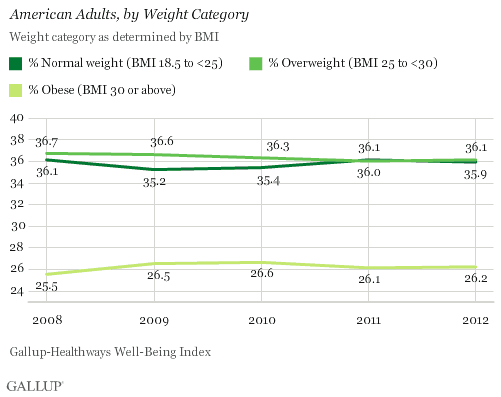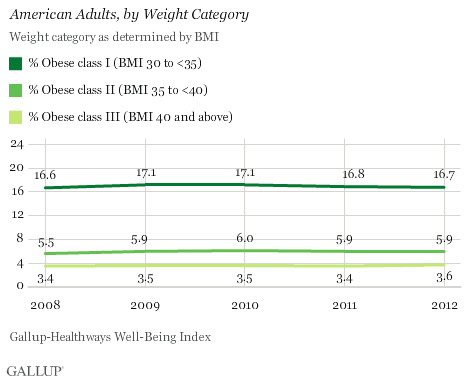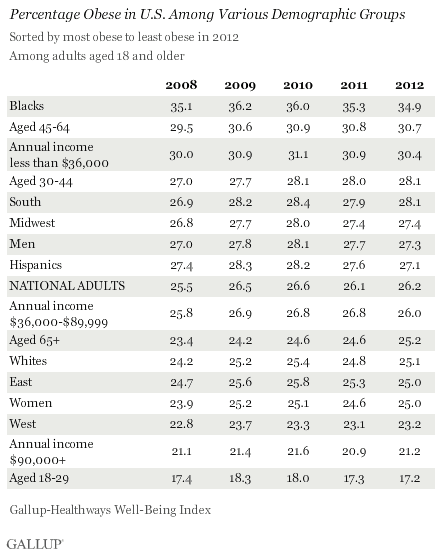WASHINGTON, D.C. -- Americans were as likely to be obese in 2012 as they were in 2011. But the 26.2% who were obese in 2012 remains slightly higher than the 25.5% recorded in 2008. Another 36.1% of Americans were overweight in 2012 and about as many were a normal weight -- 35.9%.

Gallup and Healthways started tracking Americans' weight daily in 2008 as part of the Gallup-Healthways Well-Being Index.
The 2012 data comprise more than 350,000 surveys of American adults. The Gallup-Healthways Well-Being Index uses respondents' self-reports of their height and weight to calculate body mass index (BMI) scores. Individual BMI values of 30 or above are classified as "obese," 25 to 29.9 are "overweight," 18.5 to 24.9 are "normal weight," and 18.4 or less are "underweight."
The World Health Organization further classifies BMIs of 30.00 or higher into one of three classes of obesity:
- Obese class I = 30.00 to 34.99
- Obese class II = 35.00 to 39.99
- Obese class III = 40.00 or higher
Those with BMIs of 40 or higher -- obese class III -- are often considered "morbidly obese." Based on self-reports of height and weight, 3.6% of American adults were "morbidly obese" in 2012. This is on par with 3.4% in 2011 and 3.5% in 2009 and 2010.
Another 16.7% of adults fell into obese class I in 2012, and another 5.9% were in obese class II. The percentage of Americans in each of these groups has remained similar over the past five years.

Obesity Rates Within Demographic Groups Remain Similar in 2012
The percentage of Americans who were obese in all major demographic and socioeconomic groups stayed about the same in 2012 compared with 2011. Blacks, those aged 45 to 64, and low-income Americans continue to be the most likely to be classified as obese, as has been the case since 2008. Those aged 18 to 29 and higher-income Americans remain the least likely to be obese.

Bottom Line
The percentage of obese adults in the United States held steady in 2012 after declining slightly in 2011. The obesity rate did not continue to decline in 2012, despite more Americans reporting frequent exercise each month and more Americans citing obesity as the most urgent health problem facing the U.S. compared with prior years.
Under the Affordable Care Act, all adults with an insurance policy beginning on or after Sept. 23, 2010, are entitled to an obesity screening and counseling at no cost. Ensuring all Americans are aware of this provision may be key to helping those who are overweight or obese achieve and maintain a healthy weight and avoid the chronic diseases associated with obesity.
Government programs and policies are not the only solution to the obesity epidemic in the United States. Gallup research shows that physicians in the U.S. are in better health than other employed adults and Americans who are engaged in their work are more likely to report having a healthier lifestyle. Thus, physicians can set a positive example for their patients and employers can promote a healthy lifestyle for their employees.
With more than one in four Americans suffering from obesity, it remains a serious public health crisis -- and one with a high cost to the U.S. economy.
About the Gallup-Healthways Well-Being Index
The Gallup-Healthways Well-Being Index tracks well-being in the U.S. and provides best-in-class solutions for a healthier world. To learn more, please visit well-beingindex.com.
Survey Methods
Results are based on telephone interviews conducted as part of the Gallup-Healthways Well-Being Index survey Jan. 1-Dec. 31, 2012, with a random sample of 353,564 adults, aged 18 and older, living in all 50 U.S. states and the District of Columbia, selected using random-digit-dial sampling.
For results based on the total sample of national adults, one can say with 95% confidence that the maximum margin of sampling error is ±0.2 percentage points.
For results based on subgroups, one can say with 95% confidence that the maximum margin of sampling error is ±1 percentage point.
Interviews are conducted with respondents on landline telephones and cellular phones, with interviews conducted in Spanish for respondents who are primarily Spanish-speaking. Each sample includes a minimum quota of 400 cellphone respondents and 600 landline respondents per 1,000 national adults, with additional minimum quotas among landline respondents by region. Landline telephone numbers are chosen at random among listed telephone numbers. Cellphone numbers are selected using random-digit-dial methods. Landline respondents are chosen at random within each household on the basis of which member had the most recent birthday.
Samples are weighted by gender, age, race, Hispanic ethnicity, education, region, adults in the household, and phone status (cellphone only/landline only/both, cellphone mostly, and having an unlisted landline number). Demographic weighting targets are based on the March 2010 Current Population Survey figures for the aged 18 and older non-institutionalized population living in U.S. telephone households. All reported margins of sampling error include the computed design effects for weighting and sample design.
In addition to sampling error, question wording and practical difficulties in conducting surveys can introduce error or bias into the findings of public opinion polls.
For more details on Gallup's polling methodology, visit https://www.gallup.com/.
